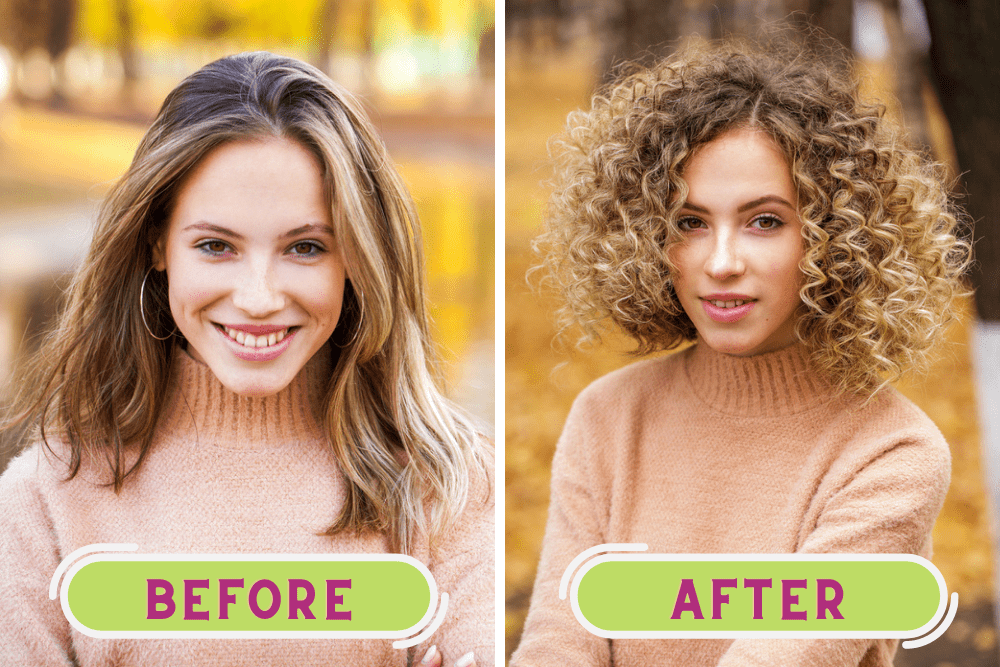How To Do a Beach Wave Perm at Home With Our DIY Beginners Guide

Beach waves have that “it” factor that everyone’s loving, and women worldwide are setting and heat-styling their hair to oblivion to get the look. But what if doing all that work is unnecessary?
That’s where the beach wave perm comes in – it could be precisely what you need to get permanent beach-ready waves!
This is your beach wave perm definitive guide, where we’ll tell you everything you need to know about the super-trendy beach wave perm, including what it is, how to do it, its damage risk, and more. Let’s get right into it!
Table of Contents
What is a Beach Wave Perm?
A beach wave perm is similar to traditional perms, where a chemical solution and rollers are applied to the hair to permanently set it in curls or waves. What’s different about the beach wave perm is that it does not create spiral curls as a standard curly perm does. It creates looser waves that look natural and mimic waves you’d see at the beach.
On average, a beach wave perm lasts anywhere from 8 weeks to 6 months. Over time, the waves will fall and become less noticeable as the effect of the perm wears off.
This type of perm is subtle when compared to other perms, which means that it requires less of an initial commitment. Wavy perms can be done on all hair types, although they’ll look different depending on your natural curl pattern.

How a Beach Wave Perm Works
It’s all in the solution used, the size of the rollers, and the rolling technique. Perm solutions usually contain a chemical called ammonium thioglycolate. This chemical removes any traces of your old curl pattern by breaking protein bonds within the hair shaft.
Then the neutralizer, which is comprised of hydrogen peroxide and other chemicals, rebuilds the bonds and sets the waves in the shape of the rods.
However you roll the hair around the rod, that’s how the resulting waves will turn out. The neutralizer also restores your hair’s normal pH levels. After neutralization, your hair is ready to be conditioned and styled as usual.

How to Do a Beach Wave Perm
Beach wave perms should be done by professionals whenever possible since they require the use of potentially dangerous chemicals.
However, if you feel confident and want to perm your hair at home, these are the steps you should follow for the best results.
Gather Your Materials
Before you get started, it’s always a good idea to make sure that you have all of the materials you’ll need for your perm:
- End papers
- Thermolizer, Waving Solution, and Neutralizer or a kit that has all of these
- Large Flexi rods
- Rattail comb
- Clarifying shampoo
- Cotton coils
- Plastic cap
Once you get your materials together, follow the below instructions to the T.
- Clarify your hair with the deep cleansing shampoo. Doing so will ensure that the perm solution will penetrate the hair with ease.
- Part out a large section of hair (about 2 inches wide and 2 inches long).
- Comb through the hair with a wide-toothed comb. You want to make sure that all of the knots are removed from the hair, so there are no kinks.
- Use your middle and pointer fingers to smooth the hair upward.
- Grab two end papers, spray them down with water, and put them on both sides of the section of hair at the ends. Smooth the end papers so that they are completely flat against the hair.
- Grab a Flexi rod and begin wrapping the section of hair around it, starting near the center of the rod. Ensure that all of the hair is wrapped smoothly around the rod.
- Roll the Flexi rod until it is flush to your scalp.
- Bend the ends of the Flexi rod inward to secure.
- Repeat steps 2-8 all over your head.
- If you notice any loose ends, that’s okay. Having some straighter pieces will make the result look more natural. But if there are lots of loose ends, do this:
- Place an end paper over the loose hair, spray it down with water, and use your comb to smooth it down in the shape of the roller.
- Once you’re done wrapping all of the hair, wrap the perimeter of your head with cotton. Doing so will protect the skin around your face from the solution.
- Put a towel all-around your neck to protect your clothes and skin.
- Now, it’s time to apply the waving solution (mix the waving solution with the thermolizer per the instructions) to all of your hair. Go rod by rod, squirting the solution all over the hair. Make sure that all of the hair around the rod is saturated. Any sections of hair that aren’t saturated in the solution will not turn out wavy.
- Allow the waving solution to process for about 20 minutes.
- Rinse the waving solution out of the hair while the rods are still installed. It could take several minutes to rinse all of the solution out.
- Apply the neutralizer to the hair to set the waves in place and stop the waving solution from processing. Allow the neutralizer to process for about 5 minutes before rinsing it out.
- Style your hair as usual.

How to Get the Best Beach Wave Perm Results
There have been many beach wave perm disasters, and we want to make sure that your hair doesn’t end up damaged, too curly, or otherwise ruined. Use the below tips to get the best results:

- Choose suitable rods. If you use rods that are too small, you will end up with curls instead of waves. The right rod size is at least 1 inch. You can go larger than 1 inch if you want an even more subtle wave.
- Part large sections. The smaller your sections, the more defined and curly your hair may end up. So, make your parts at least 2 inches wide and 2 inches long for the best results.
- Start with clean hair. With some chemical processing types, like bleaching and dyeing, it’s recommended not to wash your hair immediately before processing. But for a perm, you definitely should. You never know what could be coating your hair, and if there’s build-up on your strands, the perm will not be able to adequately penetrate the hair cuticle. So, do yourself a favor and clarify your hair before perming it.
- Don’t wrap too loosely. If you’ve chosen large enough rods, wrap your hair snugly around them. But at the same time, you don’t want to wrap them too tightly, as that could lead to scalp pain and irritation as you apply the perm solution.
- Rinse thoroughly each time. After your perm solution processes, take your time and rinse all of the solution out. If you leave any of the solution in, it could dry out your hair beyond belief. This tip also goes for rinsing out the neutralizing solution.
Beach Wave Perm Risks

Though beach wave perms look harmless, there are some risks associated with the styling service. And it’s in your best interest to know about all of them before taking the plunge. That’s what we’ll cover in this section.
Hair Dryness
A beach wave perm can be hard on your hair, given that it requires you to use harsh chemicals that change the structure of your hair.
These chemicals often leave your hair in a super dry state. Given that hair needs moisture to thrive, lack of moisture can cause many issues, from brittleness to breakage.
This means that to keep your hair on your head, you’ll need to take extra steps to keep it moisturized (more on this later on).
Undesired Results
Whether you’ll be doing your perm yourself or enlisting the help of a professional stylist, there’s always a chance that your perm could take a turn for the worse.
Your waves could end up too tight or too loose, defeating the purpose of the perm in the first place. It’s never recommended to have two perms back-to-back to fix a bad result, so even if you don’t like the result, you’re stuck with it for a while.
Overprocessing
Overprocessed hair is a common cause of hair failure and breakage. If your hair is already bleached or highlighted with high-lift color, you’re at high risk of severe hair damage from the perm.
The damage may be immediate, where you see hair coming out as you rinse off the perming solution, or it could happen over time, where you notice that your hair is splitting, getting thinner, or falling out.

Chemical Damage
Any chemical process carries along with it the potential for chemical damage, from scalp irritation, redness, and peeling, to painful burns. It could take days to weeks for the irritation and damage to remedy itself.
If your scalp is burning during your perm, rinse it out promptly and assess the damage. If it is minor, antibacterial ointments or creams may do the trick. But if the damage is severe, a trip to the doctor may be in order.
We did not include this section to scare you away. The vast majority of perms come with only minimal hair damage. However, you should be aware of these risks before you take the plunge.
How to Care for Your Hair Post-Perm
Perms of any kind leave your hair with some degree of damage. This is because the chemicals penetrate your hair and alter its internal structure, leaving your hair weaker and more prone to damage. So, you’ll need to take extra care of your hair afterward to keep your beach waves looking and feeling healthy.

- Take care of your hair immediately after your perm:
- Avoid brushes for the first few days. Instead, use a wide-toothed comb.
- Avoid heat styling for a couple of days. The heat will reopen your hair cuticle and cause your waves to fall.
- Don’t shampoo your hair for 2 to 3 days. Doing so can be bad for your hair since it’s been freshly processed.
- Don’t allow pressurized water to hit your hair for the first couple of days. It could cause the curls to loosen up.
- Stay away from pools and hot tubs for the first week or so. The chemicals in the water can react with your hair and alter the look of your new waves.
- Use gentler shampoo – If you regularly use harsh sulfate shampoos, now’s the time to throw them out and replace them with milder sulfate-free shampoos. These shampoos clean just as effectively as sulfate shampoos but don’t leave your hair feeling like straw. Since perms may leave your hair drier than usual, washing out the moisture that remains is just not a good idea. Also, your new curl pattern makes it difficult for your scalp’s oils to lubricate your hair. So, you should try to preserve as much moisture as you can.
- Start deep conditioning – Deep conditioning your hair is one of the best things you can do for your hair post-perm. Your hair may be calling out for moisture after the perming process, so you should give it what it needs. A deep conditioner is a heavy-duty conditioner that provides your hair with deeper moisture than traditional rinse-out conditioners. These products are often fortified with oils, emollients, humectants, vitamins, and fatty alcohols, all of which your hair needs after a harsh chemical process. If your hair feels dry or crunchy to the touch, we recommend deep conditioning your hair every few days to a week. Once your hair has appeared to bounce back, you can space your deep conditioning sessions out to once a week or twice a month.
- Use defining creams, gels, and sprays – Sometimes, people hate their new perm because their waves or curls don’t look defined. But the truth is that your new waves may need a bit of manual defining. The easiest way to define your waves is with a defining cream, spray, or gel. These products can take your newly-permed hair from a frizzy mess to a mess of gorgeous waves. A couple of great defining products include Living Proof Curl Defining Gel, DevaCurl Wave Maker, and Herbal Essences Set Me Up Spray Gel. You may need to try several to find the right one for your hair.
Should You Get a Beach Wave Perm?

If you’re on the fence regarding whether you should get a beach wave perm, you’re not alone. Getting a perm is a big decision that can drastically change how your hair looks and behaves.
In this section, we’d like to give you some additional information to help you decide whether a beach wave perm is for you.
Do You Have Enough Hair for a Beach Wave Perm?
You don’t necessarily need super long hair for a beach wave perm. But you do need hair that’s long enough to wrap around the rod a few times. If you can only wrap your hair around the rod once, you should wait until your hair is a few inches longer. If your hair is long enough, proceed to the next section.
Is Your Hair Damaged?
Sometimes, it can be difficult to tell whether your hair is damaged. But here are some signs to look out for:
- Your hair is always dry no matter what you do to remedy it.
- You deal with a lot of split ends.
- Your hair is thinning or breaking at the roots.
- You find that your hair is suddenly difficult to style.
- Your hair feels gummy or stringy.
- Your hair feels rough when you run your fingers through it.
- Your curly hair is straight in some areas.
If, after reading the above section, you think that your hair is damaged, you should hold off on getting a perm. The perm could ruin your already compromised hair. If your hair is in good condition, proceed to the next section.

Do You Regularly Color Your Hair?
Coloring or otherwise processing your hair is a big no-no both before and after a perm. So, if your hair is color-treated or you plan on switching up your hair color, a perm is not a good idea. If you’re not into coloring your hair, continue to the next section.
Are You Ready for the Upkeep?
After getting a perm, you’ll need to change up your hair routine drastically. From switching out your hair products to doing deep conditioning sessions, it’s a lot of work.
But if you don’t care for your hair adequately after getting a perm, your hair health could quickly go downhill. So, if you’re not ready for the work that getting a perm entails, you’re better off passing on it.
- Different Types of Perms for Thin Hair
- Curly Girl Method Steps for Wavy Hair
- DIY Deva Cut for Wavy Hair
- How To Do a Body Wave Perm for Naturally Curly Hair at Home
Conclusion
In a nutshell, if your hair is in good condition, you have enough hair, and you’re ready for the upkeep, go ahead and try a beach wave perm.
Not only will you love waking up to beach-ready hair every morning, but you’ll also be able to shave a ton of time off your regular styling routine! We hope this article has given you all of the information you need to decide whether a beach wave perm is for you. We wish you and your hair the best!







